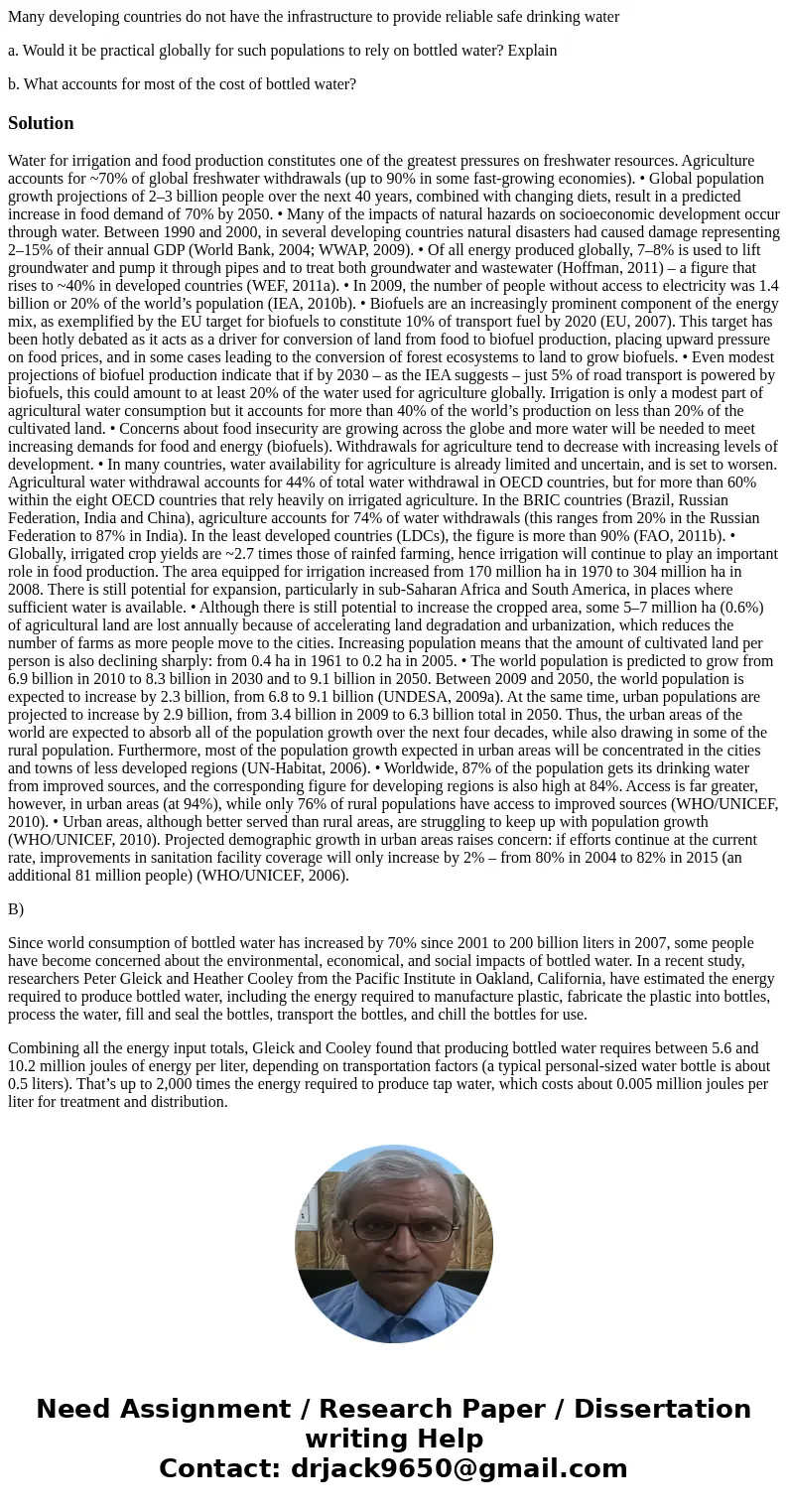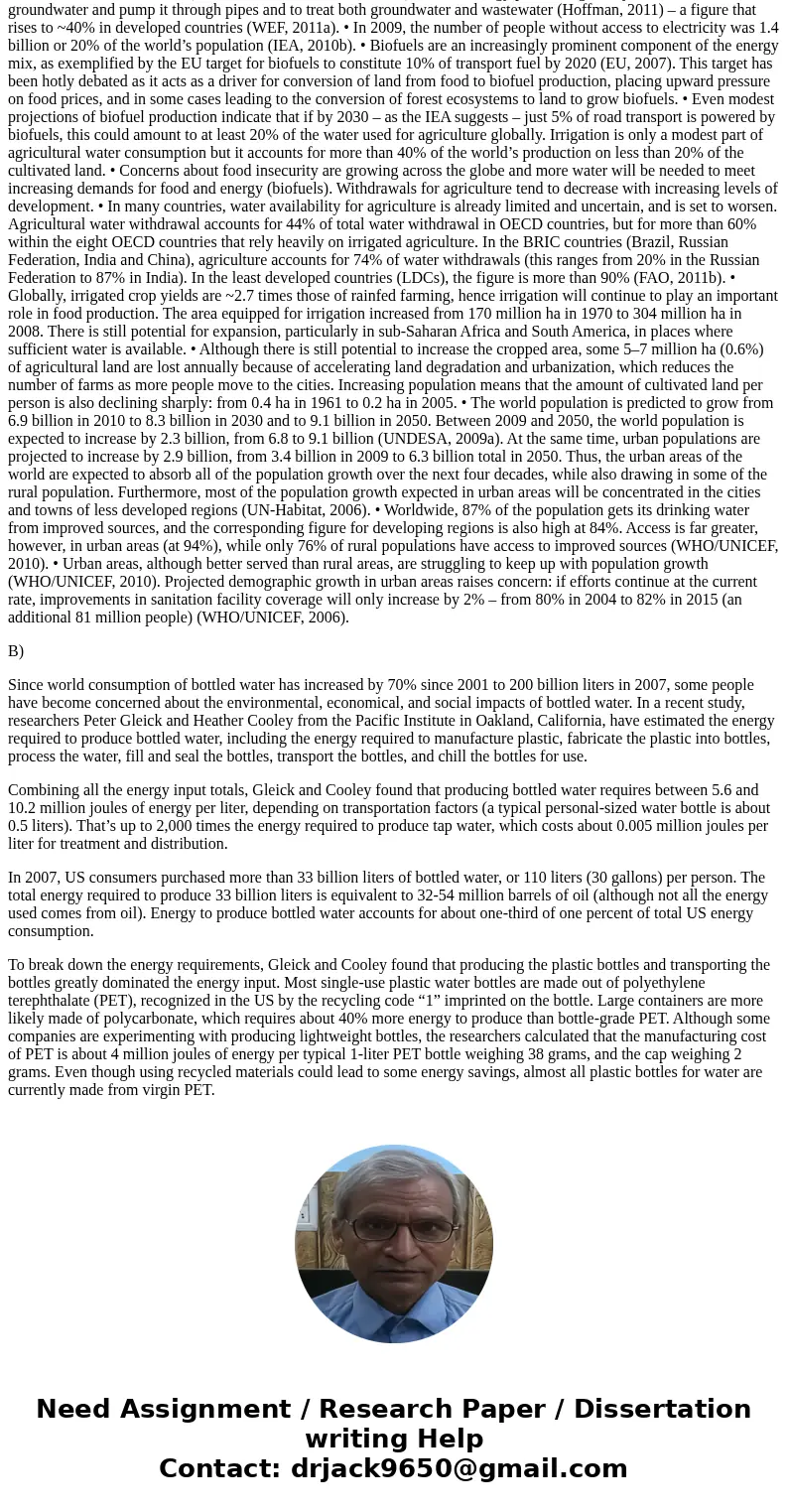Many developing countries do not have the infrastructure to
Many developing countries do not have the infrastructure to provide reliable safe drinking water
a. Would it be practical globally for such populations to rely on bottled water? Explain
b. What accounts for most of the cost of bottled water?
Solution
Water for irrigation and food production constitutes one of the greatest pressures on freshwater resources. Agriculture accounts for ~70% of global freshwater withdrawals (up to 90% in some fast-growing economies). • Global population growth projections of 2–3 billion people over the next 40 years, combined with changing diets, result in a predicted increase in food demand of 70% by 2050. • Many of the impacts of natural hazards on socioeconomic development occur through water. Between 1990 and 2000, in several developing countries natural disasters had caused damage representing 2–15% of their annual GDP (World Bank, 2004; WWAP, 2009). • Of all energy produced globally, 7–8% is used to lift groundwater and pump it through pipes and to treat both groundwater and wastewater (Hoffman, 2011) – a figure that rises to ~40% in developed countries (WEF, 2011a). • In 2009, the number of people without access to electricity was 1.4 billion or 20% of the world’s population (IEA, 2010b). • Biofuels are an increasingly prominent component of the energy mix, as exemplified by the EU target for biofuels to constitute 10% of transport fuel by 2020 (EU, 2007). This target has been hotly debated as it acts as a driver for conversion of land from food to biofuel production, placing upward pressure on food prices, and in some cases leading to the conversion of forest ecosystems to land to grow biofuels. • Even modest projections of biofuel production indicate that if by 2030 – as the IEA suggests – just 5% of road transport is powered by biofuels, this could amount to at least 20% of the water used for agriculture globally. Irrigation is only a modest part of agricultural water consumption but it accounts for more than 40% of the world’s production on less than 20% of the cultivated land. • Concerns about food insecurity are growing across the globe and more water will be needed to meet increasing demands for food and energy (biofuels). Withdrawals for agriculture tend to decrease with increasing levels of development. • In many countries, water availability for agriculture is already limited and uncertain, and is set to worsen. Agricultural water withdrawal accounts for 44% of total water withdrawal in OECD countries, but for more than 60% within the eight OECD countries that rely heavily on irrigated agriculture. In the BRIC countries (Brazil, Russian Federation, India and China), agriculture accounts for 74% of water withdrawals (this ranges from 20% in the Russian Federation to 87% in India). In the least developed countries (LDCs), the figure is more than 90% (FAO, 2011b). • Globally, irrigated crop yields are ~2.7 times those of rainfed farming, hence irrigation will continue to play an important role in food production. The area equipped for irrigation increased from 170 million ha in 1970 to 304 million ha in 2008. There is still potential for expansion, particularly in sub-Saharan Africa and South America, in places where sufficient water is available. • Although there is still potential to increase the cropped area, some 5–7 million ha (0.6%) of agricultural land are lost annually because of accelerating land degradation and urbanization, which reduces the number of farms as more people move to the cities. Increasing population means that the amount of cultivated land per person is also declining sharply: from 0.4 ha in 1961 to 0.2 ha in 2005. • The world population is predicted to grow from 6.9 billion in 2010 to 8.3 billion in 2030 and to 9.1 billion in 2050. Between 2009 and 2050, the world population is expected to increase by 2.3 billion, from 6.8 to 9.1 billion (UNDESA, 2009a). At the same time, urban populations are projected to increase by 2.9 billion, from 3.4 billion in 2009 to 6.3 billion total in 2050. Thus, the urban areas of the world are expected to absorb all of the population growth over the next four decades, while also drawing in some of the rural population. Furthermore, most of the population growth expected in urban areas will be concentrated in the cities and towns of less developed regions (UN-Habitat, 2006). • Worldwide, 87% of the population gets its drinking water from improved sources, and the corresponding figure for developing regions is also high at 84%. Access is far greater, however, in urban areas (at 94%), while only 76% of rural populations have access to improved sources (WHO/UNICEF, 2010). • Urban areas, although better served than rural areas, are struggling to keep up with population growth (WHO/UNICEF, 2010). Projected demographic growth in urban areas raises concern: if efforts continue at the current rate, improvements in sanitation facility coverage will only increase by 2% – from 80% in 2004 to 82% in 2015 (an additional 81 million people) (WHO/UNICEF, 2006).
B)
Since world consumption of bottled water has increased by 70% since 2001 to 200 billion liters in 2007, some people have become concerned about the environmental, economical, and social impacts of bottled water. In a recent study, researchers Peter Gleick and Heather Cooley from the Pacific Institute in Oakland, California, have estimated the energy required to produce bottled water, including the energy required to manufacture plastic, fabricate the plastic into bottles, process the water, fill and seal the bottles, transport the bottles, and chill the bottles for use.
Combining all the energy input totals, Gleick and Cooley found that producing bottled water requires between 5.6 and 10.2 million joules of energy per liter, depending on transportation factors (a typical personal-sized water bottle is about 0.5 liters). That’s up to 2,000 times the energy required to produce tap water, which costs about 0.005 million joules per liter for treatment and distribution.
In 2007, US consumers purchased more than 33 billion liters of bottled water, or 110 liters (30 gallons) per person. The total energy required to produce 33 billion liters is equivalent to 32-54 million barrels of oil (although not all the energy used comes from oil). Energy to produce bottled water accounts for about one-third of one percent of total US energy consumption.
To break down the energy requirements, Gleick and Cooley found that producing the plastic bottles and transporting the bottles greatly dominated the energy input. Most single-use plastic water bottles are made out of polyethylene terephthalate (PET), recognized in the US by the recycling code “1” imprinted on the bottle. Large containers are more likely made of polycarbonate, which requires about 40% more energy to produce than bottle-grade PET. Although some companies are experimenting with producing lightweight bottles, the researchers calculated that the manufacturing cost of PET is about 4 million joules of energy per typical 1-liter PET bottle weighing 38 grams, and the cap weighing 2 grams. Even though using recycled materials could lead to some energy savings, almost all plastic bottles for water are currently made from virgin PET.


 Homework Sourse
Homework Sourse